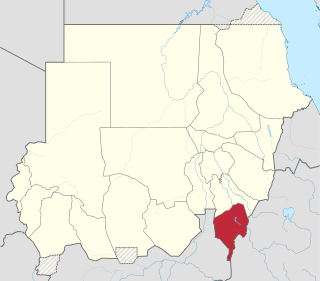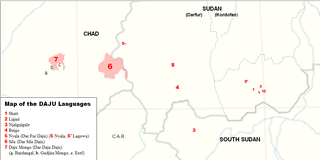
The demographics of Sudan include the Sudanese people and their characteristics, Sudan, including population density, ethnicity, education level, health, economic status, religious affiliations, and other aspects of the population.

The rich and varied music of Sudan has traditional, rural, northeastern African roots and also shows Arabic, Western or other African influences, especially on the popular urban music from the early 20th century onwards. Since the establishment of big cities like Khartoum as melting pots for people of diverse backgrounds, their cultural heritage and tastes have shaped numerous forms of modern popular music. In the globalized world of today, the creation and consumption of music through satellite TV or on the Internet is a driving force for cultural change in Sudan, popular with local audiences as well as with Sudanese living abroad.

The Kakwa people are a Nilotic ethnic group and part of the Karo people found in north-western Uganda, south-western South Sudan, and north-eastern Democratic Republic of the Congo, particularly to the west of the White Nile river.
Booya or booyah or BOOYAH may refer to:

The Beja people are a Cushitic ethnic group native to the Eastern Desert, inhabiting a coastal area from southeastern Egypt through eastern Sudan and into northwestern Eritrea. They are descended from peoples who have inhabited the area since 4000 BC or earlier, although they were Arabized by Arabs who settled in the region. They are nomadic and live primarily in the Eastern Desert. The Beja number around 1,900,000 to 2,759,000.

Blue Nile State is one of the eighteen states of the Republic of the Sudan. It was established by presidential decree nº 3 in 1992 and it is named after the Blue Nile River.

The Daju languages are spoken in isolated pockets by the Daju people across a wide area of Sudan and Chad. In Sudan, they are spoken in parts of the regions of Kordofan and Darfur, in Chad they are spoken in Wadai. The Daju languages belong to the Eastern Sudanic subfamily of Nilo-Saharan.

The Bishari are a Cushitic ethnic group ethnic group who live in parts of Northeast Africa. They are one of the major divisions of the Beja people. Apart from local dialects of Arabic, the Bishari speak the Beja language, which belongs to the Afroasiatic family of the Cushitic branch.
The Shatt language is a Daju language of the Eastern Daju family spoken by the Shatt people in the Shatt Hills southwest of Kaduqli in South Kordofan province in southern Sudan.

The Avukaya are an ethnic group of South Sudan. Some members of this ethnic have fled to the Democratic Republic of the Congo due to persecution. About 50,000 members of this ethnic group live in South Sudan. Many members of this ethnic group belong to the Christian minority of South Sudan. The Avukaya traditionally live in a rain-forest area in Equatoria close to the Democratic Republic of Congo in Southern Sudan.
The Logo people or Logoa (plural) are an ethnic group of Nilotic origin who live predominantly in the north-east of the Democratic Republic of the Congo as well as parts of western Uganda and southern South Sudan. There are believed to be more than 200,000 people who identify as ethnically Logo of whom most live in the Congo's Faradje Territory, a remote region in Haut-Uélé Province, where they form the ethnic majority. Logo people also live in Watsa and Aba, both also in Haut-Uélé, and in Yei in South Sudan.
Ngulgule is an ethnic group of South Sudan living in Western Bahr el Ghazal just north of the confluence of the Sopo and Boro rivers. They are one of seven distinct ethnicities comprising the Daju people. They speak Njalgulgule, a Nilo-Saharan language. Most of them are Muslims. The population of this group is 900.
Tama are a non-Arab, African ethnic group of people who live in eastern Chad and western Sudan. They speak Tama, a Nilo-Saharan language. The population is 200,000–300,000 people and they practice Islam. Many Tama are subsistence farmers who live in permanent settlements and some raise livestock. In the civil war in Chad the Tama were involved in ethnic conflicts with the Zaghawa tribe.
The Thuri, also known as Shatt, and Luo people of South Sudan. They speak DheThuri, a Luo language that is similar to the Jur and Dinka languages. Having been perceived as close to the Dinka people, the Thuri were targets of ethnic violence during the Second Sudanese Civil War, when the "Army of Peace", a mostly Fertit pro-government militia, attacked them as supporters of the mostly Dinka SPLA rebels. This caused many Thuri to take up arms and to join the SPLA in order to take revenge against other Fertit groups.
The Daju people are a group of seven distinct ethnicities speaking related languages living on both sides of the Chad-Sudan border and in the Nuba Mountains. Separated by distance and speaking different languages, at present, they generally have little cultural affinity to each other.

The culture of South Sudan encompasses the religions, languages, ethnic groups, foods, and other traditions of peoples of the modern state of South Sudan, as well as of the inhabitants of the historical regions of southern Sudan.

South Sudan is home to around 60 indigenous ethnic groups and 80 linguistic partitions among a 2021 population of around 11 million. Historically, most ethnic groups were lacking in formal Western political institutions, with land held by the community and elders acting as problem solvers and adjudicators. Today, most ethnic groups still embrace a cattle culture in which livestock is the main measure of wealth and used for bride wealth.
The Black people of Yarmouk Basin are an Afro-Arab ethnic group in Syria. Most live in southwestern Daraa Governorate.
The Army of Peace was a large alliance of Fertit tribal militias in Western Bahr el Ghazal during the Second Sudanese Civil War. Although initially armed by the Sudanese government in order to fight against South Sudanese separatists, the Army of Peace became especially notorious for massacring Dinka civilians. These mass killings grew so excessive that the group even came into violent conflicts with other pro-government forces. The militia was mostly disbanded in 1988, though a rump faction continued to be active and joined the Popular Defence Forces in 1989, and later the South Sudan Defense Forces (SSDF) in 1997.









